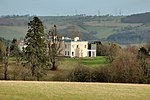St Cadoc's Church, Llangattock Vibon Avel
14th-century church buildings in WalesChurch in Wales church buildingsChurches preserved by the Friends of Friendless ChurchesChurchyards in WalesGrade II* listed churches in Monmouthshire ... and 1 more
History of Monmouthshire

The Church of St Cadoc, Llangattock Vibon Avel, Monmouthshire is a parish church of medieval origins which was heavily restored in the 19th century. The estate church of The Hendre, it is closely connected with the Rolls family and the grave of Charles Stewart Rolls, the motoring and aviation pioneer, is located in the churchyard. The church is a Grade II* listed building and is now in the care of the Friends of Friendless Churches.
Excerpt from the Wikipedia article St Cadoc's Church, Llangattock Vibon Avel (License: CC BY-SA 3.0, Authors, Images).St Cadoc's Church, Llangattock Vibon Avel
Whitehill Lane,
Geographical coordinates (GPS) Address External links Nearby Places Show on map
Geographical coordinates (GPS)
| Latitude | Longitude |
|---|---|
| N 51.837 ° | E -2.79 ° |
Address
Saint Cadoc
Whitehill Lane
NP25 5NH , Whitecastle
Wales, United Kingdom
Open on Google Maps











